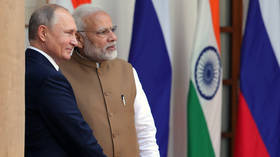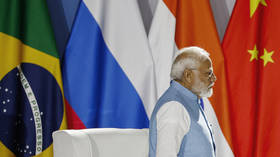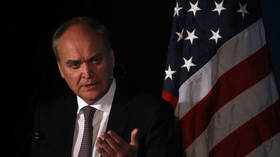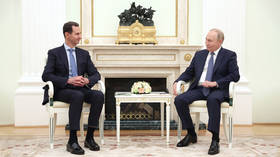Can Putin and Modi resolve this decades-old dilemma?
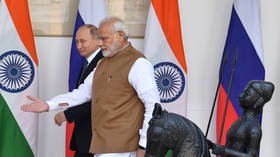
During Indian Prime Minister Narendra Modi’s official state visit to Russia next week, one of the major issues on his agenda is bound to be the growing trade imbalance between the two countries and finding an agreeable alternative currency for the blossoming bilateral economic relations between the two civilizational giants.
New Delhi and Moscow once witnessed the successful implementation of the 1953 Indo-Soviet Trade Agreement. Even then, the trade imbalance was a major issue, with India importing a lot more than it exported to the USSR, and the rupee being non-convertible. The accumulated Soviet rupee balances with the RBI took around 16 years to be fully liquidated by the union's successor state, Russia, after the dissolution of the agreement in 1992.
In the immediate aftermath of the USSR’s breakup, the Soviet banking system was dismantled and catastrophically restructured, as policymakers heeded the advice of American banking experts. As the economy went into a freefall, the ruble, now no longer supported by state regulations, spiraled into oblivion on the free market. The spot exchange rate at that point was 488 rubles per US dollar. The states that owed debts to USSR’s successor, Russia, either paid them back at extremely favorable market rates or refused to pay at all, citing the cessation of the USSR as a legal entity.
India on the other hand, under the leadership of then-Prime Minister Narsimha Rao and Finance Minister Manmohan Singh, finalized a rupee-ruble deal where the ruble was artificially valued at a thousand times more than its current market value. Therefore, the exchange rate was pegged not at the prevailing 488 rubles/dollar but at 0.78 rubles/dollar - the rate which existed in late 1989. Despite facing a balance of payments crisis with critically low foreign exchange reserves, New Delhi sought the full repayment of its 9.9 billion ruble debt in a manner which was favorable to the nascent Russian Federation.
Glaring Rupee stash
Today, amid the ongoing Ukraine conflict, the rupee-ruble payment settlement mechanism is again one of the key focal points of high-level discussions between the two countries. Much more than before, this mechanism faces formidable obstacles which stem from an inherent imbalance of trade relations.
Since the start of the crisis, Western-backed sanctions on Russia's oil industry have meant that Moscow has started offering discounts to its remaining prospective buyers, one of which is India. Indian imports of Russian crude have witnessed an astronomical 13-fold rise, from less than $2.5 billion in 2021-22 to over $31 billion in the year 2022-23. In comparison, Moscow has imported around $6-7 billion of Indian products, leading to a large trade imbalance in the former’s favor.
There also exist other complications regarding the utilization of the rupees that Russia possesses in Indian banks. Firstly, the currency is not freely convertible. Given that India only accounts for 2% of globally produced goods, the rupee isn’t held by many nations.
Secondly, the Indian economy currently has a regime in place restricting capital outflows by foreign investors, which further complicates Moscow’s efforts to pull out its funds from the country.
Third, the lack of Indian exports to Russia means that Moscow’s attempts at reinvesting or utilizing its Rupee funds for payments for Indian goods remains limited at best.
However, recently the Reserve Bank of India (RBI) has lifted restrictions for a total of 22 countries, allowing them to open Special Vostro Rupee Accounts (SVRAs) thus broadening rupee trade settlements. This move is likely to induce increased accessibility and convenience for rupee trade settlements, thus allowing the countries greater autonomy in conducting transactions without using the US dollar. Further relaxing the guidelines, the RBI recently also announced the possibility of opening an additional account for export proceeds, thereby providing much-needed impetus to the Rupee as a currency for settling international transactions.
Move towards de-dollarization
The global economy is increasingly moving away from unipolar dollar dominance to a more bipolar model signifying the primacy of the American dollar and the Chinese yuan, among other small yet vital currencies like the euro, pound and yen. This move towards de-dollarization was recently underscored when Saudi Arabia refused to extend the US-Saudi Petro-dollars deal.
While moving away from Western economic processes and stimulated by prohibitive sanctions, the Russian economy is tilting prominently towards utilizing the yuan as an alternative currency. Its share in exchange trading stood at a record 53.6% in May while commanding a 39.2% share in the over-the-counter market.
This explains Moscow’s insistence that it settle trade payments between Russia and India in yuan, something which New Delhi isn’t comfortable about. A simmering troop standoff at the border with China which led to a deadly clash in 2020 has invariably cooled relations between the Asian giants. New Delhi is therefore wary of increasing its trade dependence on yuan – a currency of a potentially adversarial state - although some Indian oil refiners have used yuan to settle crude payments due to the lack of an alternative viable currency.
Furthermore, with China buying large quantities of Russian crude and Moscow’s brightening prospects of withstanding global sanctions, the Kremlin has reduced discounts on its crude exports, leading to two major repercussions.
First, India, which has refused to sign the Western-led price cap on Russian oil but tacitly agreed to uphold it as much as possible, used to benefit from crude discounts which ensured the price remained well under the West-signified limit, thus allowing payments in dollars. Reportedly, with the reduction of discounts owing to a greater crude demand from China and complex sanctions-evading logistics, New Delhi faces the risk of breaching the price cap, thus increasing the significance of the use of alternative currencies to the dollar.
Second, the reduced discounts have led to a ballooning trade deficit for India, which has consistently sought to control its debt-to-GDP ratio. This, however, has not stopped New Delhi from importing Russian crude which, despite lowered discounts, is cheaper than other West Asian alternatives.
Options on the table
Multiple solutions can be explored to resolve the issue of stranded Russian funds as well as the larger trade imbalance.
One of the easiest methods calls for Moscow to reinvest its rupee reserves directly into the Indian economy through capital markets. On the downside, this gives Moscow little flexibility in utilizing those funds for other expenditures and purposes. What remains to be seen is how the new guidelines relaxing restrictions will impact the ongoing bilateral trade between the two nations.
A second, more long-term option involves India focusing on enhancing its exports to Russia, primarily through developing its semiconductor (SMC) industry. As the conflict in Ukraine drags on, the Russian military-industrial ecosystem has been importing dual-use SMCs, primarily from China and other countries like the UAE and Turkey. The Indian SMC market is expected to reach $55 billion in total valuation by 2026, largely driven by smartphones, wearables and automobiles. The Indian government, with its India Semiconductor Mission (ISM), has recently made a big push towards localizing the entire SMC ecosystem – from designing, research and development, to fabrication – in order to achieve technological sovereignty.
Possessing the advantage of a robust, world-class IT industry and with Russian assistance, establishing the industry would take time albeit with relative ease. While still lagging in the production of cutting-edge, contemporary chips, the Russian SMC industry is capable of producing older-generation 180 nanometer, 90 nanometer, and at times 65 nanometer chips. Knowledge and technical understanding of how to produce these chips can be transferred to the still-developing Indian semiconductor industry.
Once established, New Delhi can emulate Beijing’s example and export much-needed dual-use SMCs to Russia, as they are in critical demand both for the consumer-based industry as well as its military-industrial complex. Growth in exports will also assist in rebalancing the one-sided bilateral trade. However, Indian authorities will need to endure heightened Western pressure, lest the country be labeled as a participant rather than a spectator in the crisis, complicating its diplomatic standing. Therefore, New Delhi will find it convenient to redirect shipping through third-party nations such as the UAE and Turkey instead of shipping it directly to Russia.
The third antidote includes a more realistic compromise involving a spit-up currency exchange system similar to the rupee-rial deal with Iran. The agreement with Tehran called for 45% of payment to be made in rupees while the rest was covered in euros wired through Turkey. For Russia, half of the payment could be in rupees while the other half could be made in an alternative currency such as Dirhams. Moscow will greatly benefit from such an agreement which increases liquidity for the Russian government while also allowing India to avoid secondary Western sanctions.
Fourth, India has recently joined Project Nexus – a multilateral initiative aimed at instant cross-border retail payments – along with four other ASEAN member nations. Under Nexus, India’s Unified Payments Initiative (UPI) will be combined with the national Fast Payment Systems of Malaysia, the Philippines, Singapore and Thailand. This would greatly simplify and accelerate instant cross-border payments for the nations involved. Project Nexus could also provide an opportunity to resolve Russia’s payment issues. Almost all the ASEAN states involved in Project Nexus share favorable ties with Moscow. Even Singapore, which implemented sanctions against Russia, has seen itself moving closer to the Kremlin as the conflict progresses.
These states can offer their national currencies for convertibility and the processing of oil payments like the UAE’s dirham. The Singaporean Dollar, due to its stability and safety, would be the natural first pick of the lot for solving convertibility issues. If capitalized on correctly, this new fledgling system could soon be the precursor of a global alternative to the current SWIFT banking system.
Finally, both states can explore the setting up of an alternative SWIFT mechanism for bilateral trade settlements. Such an architecture could be based on the Russian SPFS network or the Indian Structured Financial Messaging System (SFMS). Such alternative mechanisms, if successful, can also serve as a foundational bedrock for multilateral non-Western organizations like BRICS+ by providing an alternative financial architecture to the current Western-dominated global financial system.
The Indian prime minister’s visit next week is occurring on the heels of India’s attendance of the Peace Summit, thereby symbolizing New Delhi’s continued strategic balancing. The talking points between the leaders are bound to be numerous – from ways to achieve peace in Ukraine to the future of BRICS+, but at the bilateral level the focus is likely to be on the issues of trade imbalance and payment settlement mechanism. One thing is certain: the upcoming visit by the head of the world’s largest democracy to a state under a maximum number of Western sanctions clearly symbolizes the rise of the non-West in a defining era of multipolarity.
The statements, views and opinions expressed in this column are solely those of the author and do not necessarily represent those of RT.


